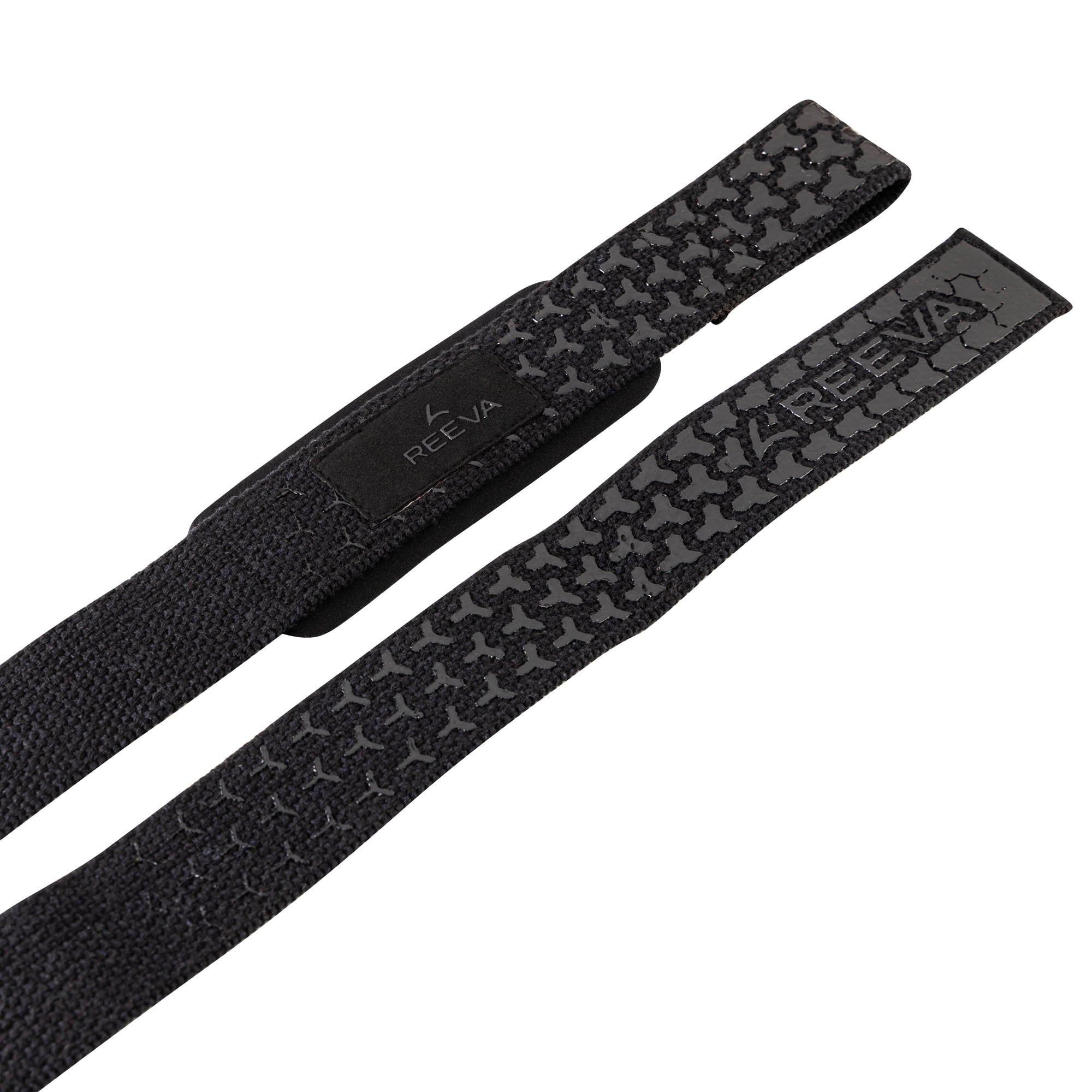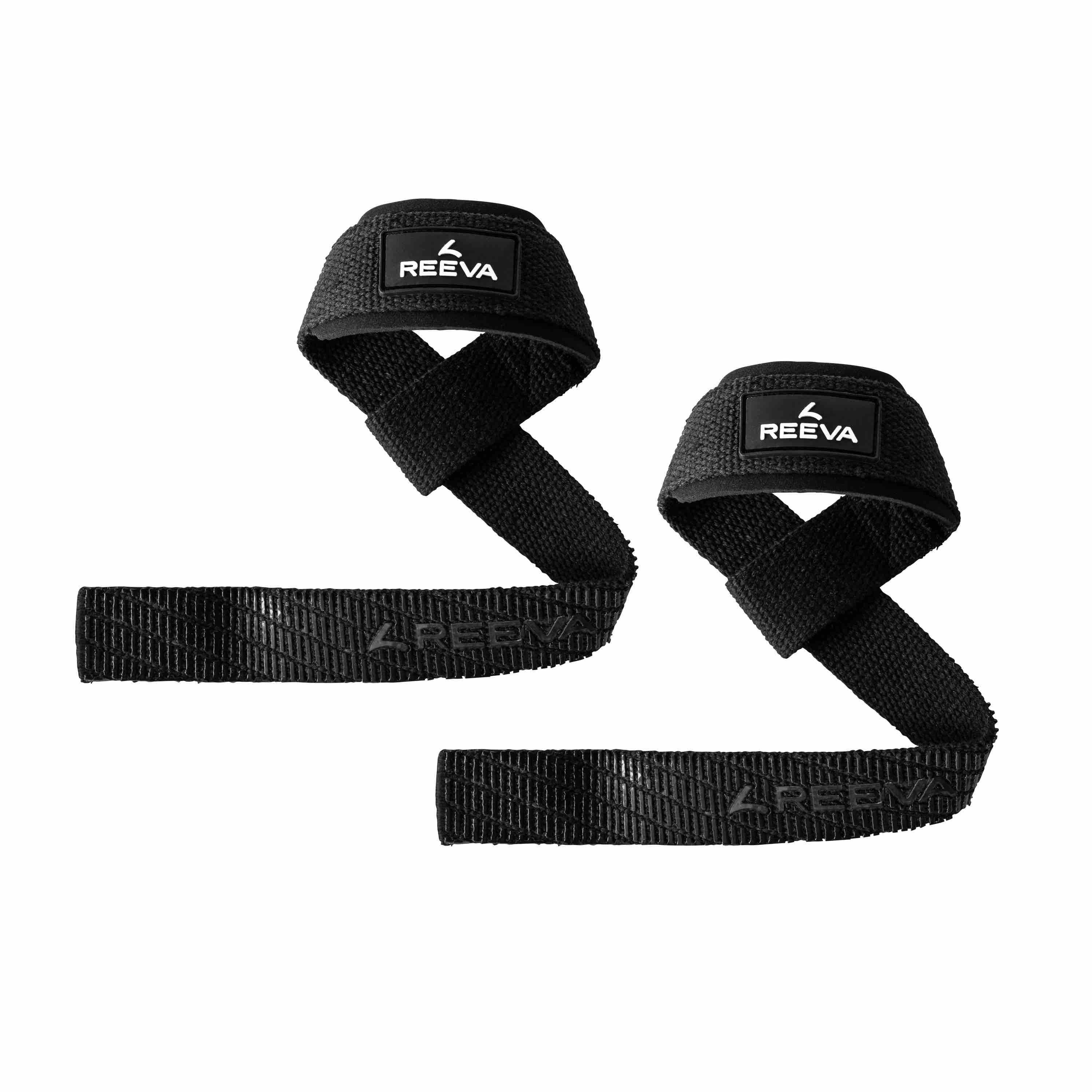Lifting Straps for Weightlifting & Grip Support
Lifting straps are essential gym accessories for strength training, providing crucial grip support when lifting heavy weights. Whether you’re deadlifting, doing rows, or pulling up your own bodyweight, a quality pair of weight lifting straps helps you hold onto the bar securely even as your grip fatigues. Reeva’s premium lifting straps are designed to help serious lifters train harder and safer by reducing grip limitations and preventing slips during maximal efforts.
What Are Lifting Straps?
Lifting straps are strong, durable bands (typically made of cotton, nylon, or leather) that loop around your wrists and the barbell to secure your grip during heavy lifts. In other words, they act as an extension of your hands, effectively fastening your palms to the bar. This prevents your hands from slipping mid-lift and allows you to lift heavier weights when grip strength is the limiting factor. Often used in weightlifting, powerlifting, and bodybuilding, lifting straps (also known as wrist straps or deadlift straps) are a go-to tool for exercises where grip can give out before the target muscles do.
(Note: Lifting straps differ from wrist wraps, which stabilize the wrist joint. Straps focus on helping you hold the weight, while wraps provide support to the wrist itself.)
Benefits of Using Lifting Straps
Using lifting straps can elevate your strength training by removing grip as a weak link. Key benefits include:
-
Secure Grip on Heavy Lifts: Straps lock your hands to the bar, so you can deadlift, barbell row, or do pull-ups without your grip slipping. This means handling heavier weights than your bare hands alone would allow, helping you build strength in larger muscle groups.
-
Reduced Grip Fatigue: By transferring some load from your fingers to your wrists, straps delay forearm fatigue. You can squeeze out extra reps and sets before grip failure kicks in, making your workouts more effective.
-
Focus on Target Muscles: With grip worries aside, you can fully focus on the muscles you’re training. Straps let you channel effort into your back, legs, or shoulders (during pulling movements) rather than into just holding onto the bar. This leads to better activation of target muscle groups like your lats, traps, and hamstrings during heavy pulls.
-
Hand Protection & Safety: Straps can help protect your hands by reducing friction and strain on your palms. They minimize issues like calluses or torn skin during high-intensity lifts. Additionally, by securing the weight, lifting straps lower the risk of a heavy barbell slipping out of your grasp, improving safety when you’re going for max reps or PRs.
In short, lifting straps serve as a grip “equalizer,” allowing you to lift more weight and train more intensely without being limited by grip strength. For many lifters, they’re a game-changer for pulling exercises.
When Should You Use Lifting Straps?
You’ll get the most benefit from lifting straps on pulling exercises and max-effort sets where grip tends to be the bottleneck. Common scenarios to use straps include heavy deadlifts, barbell or dumbbell rows, weighted pull-ups or lat pull-downs, shrugs, and other pulling movements that require significant grip strength. For example, powerlifters often use “deadlift straps” on their heaviest sets, and Olympic weightlifters might use straps when doing high-rep snatches or pulls, especially when grip endurance is taxed.
As a rule of thumb, beginners should first build a baseline of grip strength (usually the first few months of training) before relying on straps. Once you’re handling weights that challenge your grip—where your target muscles could do more, but your hands are giving out—that’s the time to grab the straps. Many experienced lifters use straps for their top heavy sets or high-volume back workouts, while still doing some exercises bare-handed to keep training their natural grip. This balanced approach ensures you get stronger overall, without your forearms holding back your progress.
(Keep in mind that in formal competitions like powerlifting or Olympic lifting, straps may not be allowed on certain lifts. Use them in training to push beyond your grip limits, then test your raw grip periodically.)
How to Use Lifting Straps
Using lifting straps properly is simple, and with a bit of practice it becomes second nature. Follow these steps to get a secure grip:
-
Loop Around Your Wrist: Take the end of the strap and feed it through the small loop on the opposite end, creating a larger loop. Slide your wrist through this so the strap lies flat against the back of your hand. Adjust it snugly around your wrist (but not so tight that it’s uncomfortable or cuts off circulation).
-
Wrap the Strap Around the Bar: Place your hand on the bar (or dumbbell handle) and drape the free end of the strap under and around the bar. Wrap it tightly by twisting the bar towards you, winding the strap around the bar one or two full rotations. The strap should coil neatly around the bar, with your hand holding the free end.
-
Grip Over the Strap: Once wrapped, grip the bar on top of the strap. Your fingers will be covering both the bar and the strap. This positioning “sandwiches” the strap between your hand and the bar, locking it in place.
-
Tighten and Lift: Before lifting, roll the bar slightly in your hands toward you – this will take up any slack in the straps and tighten them securely around the bar. Now, with the strap aiding your grip, perform your lift as usual. You should feel the bar held firmly in place by the straps as you pull.
Figure: A lifter using lifting straps to secure grip during a heavy deadlift. Straps are especially useful for exercises like deadlifts, rows, and pull-ups where grip strength can limit performance.
After your set, simply release your grip and unwind the straps from the bar. Pro tip: It might feel a bit awkward the first couple of times, but strapping in becomes quick and seamless with practice. Before long, you’ll be able to strap both hands onto the bar in seconds and focus entirely on your lift.
Reeva Lifting Straps – Premium Gear for Serious Lifters
Not all lifting straps are created equal. Reeva’s lifting straps stand out as premium gear built for athletes who demand quality, comfort, and performance. Our straps are crafted with top-tier materials and thoughtful design features that help you train better:
-
Durable, Heavy-Duty Construction: Made from high-grade sustainable cotton, Reeva straps are both eco-friendly and extremely tough. The heavy-duty cotton webbing is built to withstand countless heavy lifting sessions without fraying or tearing. When you invest in our straps, you’re getting a product designed to outlast your toughest workouts.
-
Non-Slip Silicone Grip: Unlike standard straps, Reeva’s lifting straps have a silicone print lining on the inside. This silicone grip provides extra friction against the bar, so the barbell practically “sticks” to your hands. Even if you’re sweating or pulling a smooth steel bar, the straps won’t slide—a significant advantage over conventional lifting straps that rely on fabric friction alone.
-
Maximum Comfort Padding: Comfort is key during big lifts. Our straps contain padded foam zones on the inside to cushion your wrists. This means no more fabric digging into your skin or bruising your wrists during heavy sets. The padding conforms comfortably and eliminates the distracting pain that cheaper, unpadded straps can cause. You can focus on your lift, not on discomfort.
-
Extra-Long, Secure Design: Reeva lifting straps are intentionally made longer (61 cm in length) than many standard straps. The added length allows you to wrap the strap around the bar an extra time for a super secure hold. More wraps translate to a tighter grip on the bar, giving you confidence to attempt that PR deadlift or high-rep set without worry. The length is optimized to fit any bar diameter and hand size, providing versatile support for different lifts.
Why choose Reeva straps over others? Simply put, our Ultra Grip Lifting Straps incorporate all the features advanced lifters look for in one package. Many basic straps on the market lack these benefits – they might be made of low-grade material, have no added grip, and offer little comfort. In contrast, Reeva’s straps are a new generation of professional lifting straps, merging durability, grip technology, and comfort. This results in a strap that outperforms conventional lifting straps in every aspect: better hold on the bar, more support for your wrists, and tougher construction for long-term use.
Reeva is proud to support everyone from champion powerlifters to everyday gym enthusiasts. Our lifting gear is even endorsed by pro athletes and tested in the most demanding training environments. When you gear up with Reeva straps, you can trust that you’re using the same quality equipment that athletes rely on for their biggest lifts.
In summary, if you’re looking for the best lifting straps to elevate your strength training, Reeva has you covered. Browse our collection of lifting straps below and get ready to train with a grip like never before!




